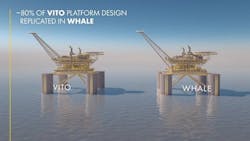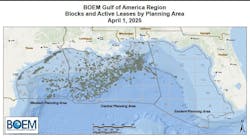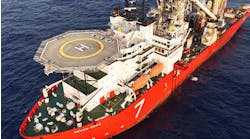OTC 2024: Shell shares lessons learned on platform replication strategy
Bruce Beaubouef * Managing Editor
HOUSTON – While oil prices have rebounded significantly since their nadir in March 2020, operators have taken the lessons of capital efficiency to heart. Shell is arguably at the forefront of implementing this engineering philosophy with its “design one, build many” approach that it has followed with its Vito and Whale production platforms, and with its upcoming Sparta platform.
The benefits and the lessons learned from this approach were presented and discussed by Shell and Seatrium officials at the panel “Mega Project: Whale Deepwater Host Replication” held at OTC 2024 on Wednesday morning.
Panel participants included Jonathan Johnson, Business Opportunity Manager–Shell Exploration; Oro Awaritefe, Project Manager–Shell; Jason Gage, Host Manager–Shell; and William Gu, Executive Vice President with Seatrium.
“After the Whale discovery, we looked at a broad spectrum of FPU options,” said Johnson, “including FPSOs, Spars, and TLPs, but none of these designs fit our needs.” Metocean conditions, among other things, argued against these deepwater platform designs. Nor would a subsea tieback suffice – “the reserve volumes are just too big.” But the Vito semisubmersible had just gone through a significant engineering redesign, “and we recognized that with this design, we could develop Whale quickly.”
At the time of Vito’s redesign and Whale’s planning, oil prices had improved to $50 per barrel, but Shell officials still wanted to move forward rapidly, but with caution and deliberation. The new operating principles were “speed, simplicity and faster cycle times,” Johnson said. Soon, “replication” became a key design parameter when designing new field architectures. In today’s environment, “we want faster, safer and simpler,” Johnson said.
Originally, Vito had been designed for “maximum recovery” but had to become “leaner and meaner” in the new economic environment, said Awaritefe. That meant that Whale had to become “leaner and meaner” too – as will the upcoming Sparta platform. “We need to remain competitive” in this marketplace, he commented, “and cycle time is a key part of that. There are huge benefits in faster construction time.”
“With Sparta, we’re not just repeating the design with Whale, but also relationships with many of the key vendors, fabricators and suppliers,” Awaritefe noted. “This helps bring certainty in the design.”
Shell officials noted that the Whale FPU is not a 100% replication of Vito – for one thing, “the fluid conditions are different from Vito,” Johnson noted, and this necessitated some differences in processing equipment. Additionally, Whale’s greater distance from shore necessitated a larger helideck, to accommodate larger helicopters. Another difference was in the mooring system, given the considerable difference between Vito’s water depth (about 4,000 feet) and Whale’s water depth (about 8,500 feet).
Awaritefe outlined the benefits of replication. “You are better able to forecast where you're going right from the beginning. There's less time spent in contracting, because you're using supply chain companies that know your specifications, and they know what you’re after. And there are repeat orders. In some cases, you can actually take the purchase orders and just change the project name on the document. We were able to cut down the amount of churn or rework by 75%. These have big impacts in time and money. So, there are great efficiencies available with replication, because there is an ease of execution that comes along with it. You have established relationships. And that human component of the equation, relating across contractual lines, is a key to success.”
Awaritefe noted that these efficiencies brought precise and significant benefits to designing the Whale FPU, with lessons learned from Vito. Engineering time for the hull was reduced by 15 months. Engineering time for the topsides was reduced by 20%.
There are some challenges with replication, Awaritefe conceded. “Sometimes it’s easier said than done. Replication is a skill, a competence.” There is sometimes resistance to change, he admitted. Further, “there is also the possibility of adopting and incorporating errors,” meaning a failure to take in all the needed lessons learned from one project to the other. Being able to retain the needed engineers, workers and crew members can be another challenge. “We have to work and guard against execution complacency, and there is also the potential for ‘stagnation’ of the staff if they perceive themselves as working in one location or in a given position too long.”
Gage noted that Shell had worked with Worley and Seatrium on both Vito and Whale, often co-locating key personnel in the same office space. Many of the equipment suppliers were the same. “So, we were able to identify vendors early, and this helped us ‘kick start’ the project by having the proper equipment, right at the start. There were a lot of lessons learned from Vito that we were able to incorporate into the Whale equipment procurement strategy.”
Gage also noted that there could be some tradeoffs with the replication strategy. Sometimes, changes are needed, he said. “There is a time and place for reasonable, deliberate adaptions and adjustments, where the value is justified.” In his view, replication could be viewed as very similar to a brownfield strategy. “With a brownfield, you don’t ask ‘what do you need?’ You say, ‘this is what you’ve got.’ So, with any proposed design change, you have to be very deliberate, and fully describe the opportunity and value that such a proposed design change would bring.”
And by having a comprehensive digital model of the Vito available, Gage noted that engineers were able to move away from paper drawing deliverables on Whale, which also brought huge workflow efficiencies. “Differences and specific designs could be quickly identified, and everyone had visibility on this process. We had good alignment with Seatrium, and there was ‘one source of truth’ with the fabricator.”
Gage also noted that the replication strategy brought “some early design wins” with the Whale project. “The weight budget turned out to be accurate, and this resulted in additional available deck space. So, we added a wing deck, and we were able to add 1,500 tons of payload onto the platform for very minimal costs, and a huge value add for flexibility.”
“Replication has added tremendous value,” Gage said. “But it still requires considerable attention to detail – not everything is precisely the same. Sometimes there end up being small differences in equipment that need to be accounted for.”
Gu echoed many of these same themes. “Replication means more than just a traditional cookie cutter approach. We always have to remain flexible and adapt and adjust in response to the supply chain.”
But he did note that the replication strategy had brought significant, measurable improvements in the shipyard, including a 95%+ compliance with IOGP regulations; a better than 99% welding success rate; and a better than 99% pressure test pass rate. These metrics were hugely important, he said, “because today’s quality is tomorrow’s safety.”
And there were additional efficiency gains from Vito to Whale, Gu observed, including a 15% reduction in steel material wastage; a 15% reduction in man-hours; and a rapid three-month timeframe from topsides integration into the hull, to sail-away. “The design one, build many will be the strategy of choice in the future,” Gu observed.
To build on these synergies, Seatrium and Shell Global Solutions International signed a non-binding Memorandum of Understanding in April to collaborate on opportunities for floating production systems.
The MoU, with a focus on project standardization and replication, seeks to promote best practices in design and construction, with both parties expected to apply lessons learned from the Vito and Whale projects, to achieve further benefits of replication.
Currently Seatrium and Shell are working on the engineering and construction of the Sparta semisubmersible platform. Shell issued the FID on the Sparta project last December, and it is expected to be in place and operational by 2028.
The Whale FPU has been installed in Alaminos Canyon block 773 and is currently undergoing the commissioning process.
05.08.2024




